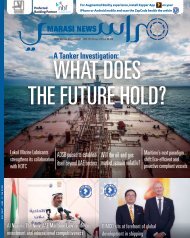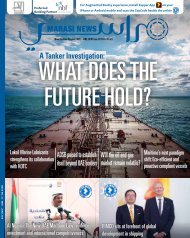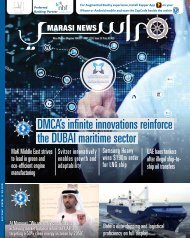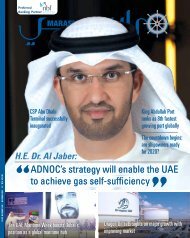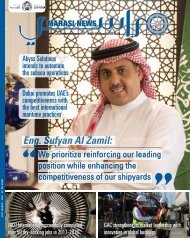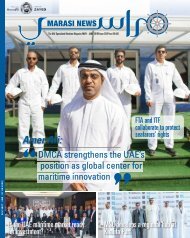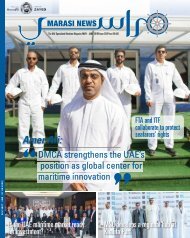Create successful ePaper yourself
Turn your PDF publications into a flip-book with our unique Google optimized e-Paper software.
tation along the routes of the Northern<br />
Sea Route for 2020 and 2030<br />
are significantly higher than those<br />
shown in the figure above. For example,<br />
according to the forecasts of<br />
Rosmorrechflot by 2020, the volume<br />
of shipments will be 44 million tons,<br />
and by 2030 it will increase to 70 million<br />
tons. According to the baseline<br />
scenario, from the Ministry of Industry<br />
and the Ministry of Natural Resources,<br />
the cargo flow through the<br />
Northern Sea Route may reach 72<br />
million tons by 2030, and in the future<br />
can grow up to 100-105 million<br />
tons. The total capacity of terminals<br />
in the seaports of Sabetta, Chaika,<br />
Tanalau, Arinay and a number of others<br />
is projected to be more than 117<br />
million tons per year. Such capacity<br />
will allow to ensure year-round movement<br />
of cargoes on the NSR.<br />
The volume of cargo transportation<br />
along the Northern Sea Route<br />
by the results of 2017 amounted to<br />
10.7 million tons, and in comparison<br />
with 2016 increased by 42.6%. 9.7<br />
million tons of cargo were transported<br />
by sea vessels, 797.2 thousand<br />
tons of river vessels were transported,<br />
194,400 tons were transported<br />
by transit vessels. It is expected that<br />
the bulk of cargo will later be associated<br />
with transportation of energy<br />
resources - liquefied natural gas<br />
(LNG) ), oil, coal, metals. Since the<br />
launch of the Yamal LNG LNG plant<br />
in December 2017, 5 LNG shipments<br />
have been sent from the Sabetta<br />
port by tanker gas carriers.<br />
China's step in Arctics<br />
Stable interest from China on the<br />
use of NSR in gas supplies is noteworthy.<br />
Commenting on the Chinese<br />
initiative of the Polar Silk Road in the<br />
Arctic, Vitaly Monkevich, president<br />
of the Russian-Asian Union of Industrialists<br />
and Entrepreneurs, said<br />
that the activity of Chinese carriers<br />
on the Yamal LNG project in 2018<br />
will grow at times. In 2017, China put<br />
Route from Yokohama to<br />
Rotterdam:<br />
Arctic route – 7300 nautic<br />
miles/20 days at sea<br />
Through Indian ocean and Suez<br />
canal – 12500 nautic miles/33<br />
days at sea<br />
As per average operational cost<br />
a day for Suezmax in average<br />
can be saved 200 000 usd/trip<br />
several transit cargo ships on the<br />
route. The way from the Asia-Pacific<br />
region to Europe along the Northern<br />
Sea Route by Chinese vessels took<br />
from seven to nine days, which is ten<br />
days shorter than the route through<br />
the Suez Canal. Accordingly, we can<br />
expect an increase in the activity of<br />
transit traffic from China to Europe,<br />
since the NSR presumes caravan<br />
tracking of ships - along with the<br />
tankers will go cargo ships. Thus, this<br />
year will see a further increase in the<br />
volume of transit cargo by the NSR.<br />
Russian icebreakers' fleet<br />
The ice fleet of Russia is 140 years<br />
old. Today, 44 ice-breakers are keeping<br />
watch, 5 of them are nuclear and<br />
39 diesel. Russia is the only country<br />
that has a fleet of nuclear icebreakers.<br />
The first five places in the rating<br />
of the ten largest icebreakers of the<br />
world were occupied by Russian icebreakers.<br />
For example, the icebreaker<br />
Yamal ranks second in the rating (laid<br />
in 1986), overcomes the ice thickness<br />
to 3 meters at a speed of 1-2 knots.<br />
In Russia, a unique experience in the<br />
construction of special equipment<br />
for the Arctic latitudes has been accumulated<br />
at the shipyards of the<br />
United Building Corporation (USC).<br />
OSK unites about 40 shipbuilding<br />
and ship repair yards, leading design<br />
bureaus and other enterprises and<br />
sets the development vector for the<br />
entire industry.<br />
In early February this year in St.<br />
Petersburg, Russia the ceremony of<br />
awarding the name of the new vessel<br />
PJSC Sovcomflot - "Yevgeny Primakov"<br />
took place. "Evgeni Primakov" is<br />
a state-of-the-art icebreaking vessel.<br />
It is built at the shipyard "Arctech<br />
Helsinki Shipyard", Finland. "Evgeni<br />
Primakov" is completing a series of<br />
4 ice-class ships built in Helsinki for<br />
the largest Russian shipping company<br />
Sovcomflot in order to service<br />
the oil and gas production platforms<br />
of the Sakhalin-2 project in the Far<br />
East. Thus, if there is a sufficient<br />
number of icebreaker escorts and<br />
parameters, the Northern Sea Route<br />
can become year-round in the wiring<br />
of ships, profitable for both transit<br />
and cabotage.<br />
Providing the Northern Sea Route<br />
is Russia's strategic task, the outcome<br />
of which will depend not only<br />
on the attractiveness of its oil and<br />
gas bearing near-Arctic territories<br />
(there are less risky territories), but<br />
also on its transit status.<br />
MARASINEWS.COM 61







